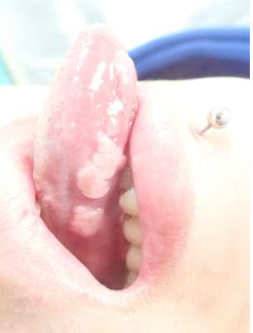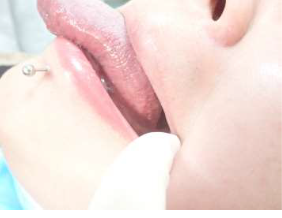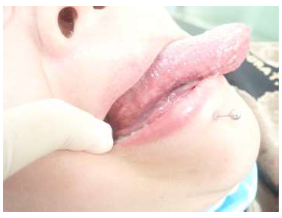Lingual Mucosal Lesions for Starting the Secondary Stage of Syphilis: A Case Report
Article Information
Min Zhao*
Department of Stomatology, Provincial Hospital Affiliated to Shandong First Medical University, Jinan 250021, China
*Corresponding Author: Min Zhao, Department of Stomatology, Provincial Hospital Affiliated to Shandong First Medical University, Jinan 250021, China.
Received: 24 April 2022; Accepted: 05 May 2022; Published: 20 May 2022
Citation: Min Zhao. Lingual Mucosal Lesions for Starting the Secondary Stage of Syphilis: A Case Report. Archives of Clinical and Medical Case Reports 6 (2022): 389-403
View / Download Pdf Share at FacebookAbstract
Background: Recent years syphilis has the increased case rates among men who have sex with men and remains a continuing public health challenge globally. Owing to its varied manifestations of oral mucosa in syphilis that can mimic other infections, it should be distinguished from oral ulcer, candidiasis, oral lichen planus, oral leukoplakia and so on.
Case Presentation: This case report describes the patient with white plaques of the lingual mucosa for the secondary stage of syphilis in a 23-year-old male. It was a rare case that oral mucosal lesions as the only manifestations of secondary syphilis. And the differential diagnosis, treatment, follow-up visits and attentions were discussed.
Conclusions: The clinicians need to distinguish the oral clinical presentations of syphilis from other oral diseases for suspected syphilis patients and to achieve early diagnosis and treatment. As well do a good job in relevant self-protection, instrument disinfection and management of nosocomial infection.
Keywords
Syphilis; Oral diseases; Case Report
Syphilis articles; Oral diseases articles; Case Report articles
Syphilis articles Syphilis Research articles Syphilis review articles Syphilis PubMed articles Syphilis PubMed Central articles Syphilis 2023 articles Syphilis 2024 articles Syphilis Scopus articles Syphilis impact factor journals Syphilis Scopus journals Syphilis PubMed journals Syphilis medical journals Syphilis free journals Syphilis best journals Syphilis top journals Syphilis free medical journals Syphilis famous journals Syphilis Google Scholar indexed journals Oral diseases articles Oral diseases Research articles Oral diseases review articles Oral diseases PubMed articles Oral diseases PubMed Central articles Oral diseases 2023 articles Oral diseases 2024 articles Oral diseases Scopus articles Oral diseases impact factor journals Oral diseases Scopus journals Oral diseases PubMed journals Oral diseases medical journals Oral diseases free journals Oral diseases best journals Oral diseases top journals Oral diseases free medical journals Oral diseases famous journals Oral diseases Google Scholar indexed journals Case Report articles Case Report Research articles Case Report review articles Case Report PubMed articles Case Report PubMed Central articles Case Report 2023 articles Case Report 2024 articles Case Report Scopus articles Case Report impact factor journals Case Report Scopus journals Case Report PubMed journals Case Report medical journals Case Report free journals Case Report best journals Case Report top journals Case Report free medical journals Case Report famous journals Case Report Google Scholar indexed journals Neoplasms articles Neoplasms Research articles Neoplasms review articles Neoplasms PubMed articles Neoplasms PubMed Central articles Neoplasms 2023 articles Neoplasms 2024 articles Neoplasms Scopus articles Neoplasms impact factor journals Neoplasms Scopus journals Neoplasms PubMed journals Neoplasms medical journals Neoplasms free journals Neoplasms best journals Neoplasms top journals Neoplasms free medical journals Neoplasms famous journals Neoplasms Google Scholar indexed journals Case Report articles Case Report Research articles Case Report review articles Case Report PubMed articles Case Report PubMed Central articles Case Report 2023 articles Case Report 2024 articles Case Report Scopus articles Case Report impact factor journals Case Report Scopus journals Case Report PubMed journals Case Report medical journals Case Report free journals Case Report best journals Case Report top journals Case Report free medical journals Case Report famous journals Case Report Google Scholar indexed journals treatment articles treatment Research articles treatment review articles treatment PubMed articles treatment PubMed Central articles treatment 2023 articles treatment 2024 articles treatment Scopus articles treatment impact factor journals treatment Scopus journals treatment PubMed journals treatment medical journals treatment free journals treatment best journals treatment top journals treatment free medical journals treatment famous journals treatment Google Scholar indexed journals CT articles CT Research articles CT review articles CT PubMed articles CT PubMed Central articles CT 2023 articles CT 2024 articles CT Scopus articles CT impact factor journals CT Scopus journals CT PubMed journals CT medical journals CT free journals CT best journals CT top journals CT free medical journals CT famous journals CT Google Scholar indexed journals surgery articles surgery Research articles surgery review articles surgery PubMed articles surgery PubMed Central articles surgery 2023 articles surgery 2024 articles surgery Scopus articles surgery impact factor journals surgery Scopus journals surgery PubMed journals surgery medical journals surgery free journals surgery best journals surgery top journals surgery free medical journals surgery famous journals surgery Google Scholar indexed journals Pathogenesis articles Pathogenesis Research articles Pathogenesis review articles Pathogenesis PubMed articles Pathogenesis PubMed Central articles Pathogenesis 2023 articles Pathogenesis 2024 articles Pathogenesis Scopus articles Pathogenesis impact factor journals Pathogenesis Scopus journals Pathogenesis PubMed journals Pathogenesis medical journals Pathogenesis free journals Pathogenesis best journals Pathogenesis top journals Pathogenesis free medical journals Pathogenesis famous journals Pathogenesis Google Scholar indexed journals Pulmonary Artery articles Pulmonary Artery Research articles Pulmonary Artery review articles Pulmonary Artery PubMed articles Pulmonary Artery PubMed Central articles Pulmonary Artery 2023 articles Pulmonary Artery 2024 articles Pulmonary Artery Scopus articles Pulmonary Artery impact factor journals Pulmonary Artery Scopus journals Pulmonary Artery PubMed journals Pulmonary Artery medical journals Pulmonary Artery free journals Pulmonary Artery best journals Pulmonary Artery top journals Pulmonary Artery free medical journals Pulmonary Artery famous journals Pulmonary Artery Google Scholar indexed journals
Article Details
Abbreviations:
T. pallidum: Treponema pallidum; MSM: men who have sex with men; CBC: complete blood count; CRP: C-reactive protein; RPR: Rapid plasma reactive ring card test; TPPA: Treponema Pallidum particle agglutination assay
1. Background
Syphilis is a chronic sexually transmitted or vertical transmitted during pregnancy disease caused by Treponema pallidum (T. pallidum). Human is the only source of infection of syphilis. Acquired syphilis is mainly transmitted through sexual contact. Recent years syphilis has the increased case rates among men who have sex with men (MSM) and remains a continuing public health challenge globally [1]. Infected individuals typically follow a disease course divided into primary, secondary, latent and tertiary stages over a period of ≥10 years and can be accompanied by oral mucosal lesions [1]. Owing to its varied manifestations of oral mucosa in syphilis that can mimic other infections, it should be distinguished from oral ulcer, candidiasis, oral lichen planus, oral leukoplakia and so on. This case report describes a rare case that the patient with lingual mucosal lesions as the only manifestations for the secondary stage of syphilis in a 23-year-old male. Combined the clinical feathers, laboratory tests and medical history, the patient was diagnosed as the secondary stage of syphilis. The differential diagnosis, treatment and follow-up visits were discussed.
2. Case Presentation
A 23-year-old man presented the stomatology department with about 3months history of pain in tongue. The patient described he felt the pain of his tongue about 3 months ago and was diagnosed with the glossitis and pharyngolaryngitis at the local clinic. He was treated with some herbs and there was no obvious curative effect and no significant improvement of his pain in tongue. The patient had history of men who has sex with men. The patient denied history of diabetes, tuberculosis, drug allergy history and family cancer. And the patient denied history of erythema, papule and other abnormal feathers of skin among the three months. Oral examination showed that white plaques on the both lateral edge of tongue, medium texture, slightly higher than the surrounding mucosa, bright surface, clear boundary, without obvious ulcers and erosions. There were no abnormal findings in the skin of limbs, trunk and genitals. Figure 1 and 2 showed the manifestations of the tongue. Laboratory examination revealed complete blood count (CBC) was normal. C-reactive protein (CRP) was elevated to 14.2mg/L (normal 0-5mg/L). Rapid plasma reactive ring card test (RPR) and Treponema Pallidum particle agglutination assay (TPPA) were positive. The RPR titer was 1:16. HIV testing were negative. The fungal smear of the oral mucosa and the lesions tested negative.

Figure1: white plaques of left lingual mucosa.

Figure 2: white plaques of right lingual mucosa.
3. Diagnosis
The diagnosis was made according to the clinical manifestation and serological test results that RPR and TPPA were positive. It has oral clinical manifestations related to secondary stage of syphilis.
4. Treatment
The patient was allergic to penicillin and was treated with oral doxycycline (twice daily with doses of 100mg per time for 14 days).
5. Follow-up and outcomes
The lesions of the tongue were vanished completely after the 14 days treatment. After 3 months of the treatment the RPR titer decreased to 1:4, and the follow-up was continued. Figure 3 and 4 showed the manifestations of the tongue after 3 months of treatment.

Figure 3: left lingual mucosa after 3 months treatment.

Figure 4: right lingual mucosa after 3 months treatment.
6. Discussion
Syphilis is a systemic chronic infectious disease caused by Treponema pallidum which is an obligate human pathogen [2]. Most acquired syphilis is transmitted through sexual contact. A few patients can be indirectly infected due to contact with underwear, bedding, towels, razors, medical instruments, breastfeeding and blood transfusion with Treponema pallidum [3]. Recently syphilis is re-emerging as a global public health problem, particularly among men who have sex with men (MSM) and there is an alarming increase of syphilis in HIV-infected MSM. Accordingly, more research is needed on the syphilis in MSM. Acquired syphilis can be divided into primary, secondary, early latent, tertiary stages of infection clinically and can be accompanied by oral lesions in these stages. Primary stage of syphilis is mainly manifested as hard chancre, and oral lesions can appear chancre in lip and tongue. The lesions of oral mucosa in secondary stage of syphilis are mainly mucositis or mucosal plaque [4]. Tertiary syphilis can manifest as destructive cardiac or neurological conditions, severe skin lesions and can also occur in the oral cavity. The common site of tertiary syphilis in the oral cavity is the hard palate, which is characterized by syphilitic gumma [5]. The lesion can cause palatal perforation, and contracture can occur after healing [5]. Literature suggests that tertiary syphilis may be less common today, perhaps owing to wide use of antibiotics [1]. In recent years, the number of patients with secondary syphilis with oral mucosal lesions as the first symptom has increased, but oral mucosal lesions as the only manifestations of secondary syphilis is rare. Oral mucosal plaque of secondary syphilis can occur in any part of oral mucosa, and the most common sites of oral mucosal plaques in secondary syphilis are lips, tongue and lingual margin, palate, pharynx and buccal mucosa. The clinical oral manifestations of secondary syphilis are complex and diverse, it needs to be distinguished from erythema, erosive lesions, papular lesions and ulcerative lesions, such as oral leukoplakia, oral lichen planus, oral candidiasis, recurrent aphthous ulcer and Behcet's disease. Clinicians should patiently ask the medical history of suspicious patients and carry out necessary serological examination. A syphilis diagnosis is often based on a suggestive clinical history and supportive laboratory tests. Serological testing such as the Rapid Plasma Reagin (RPR) test and the T. pallidum passive particle agglutination (TPPA) has become the most common means to diagnose syphilis whether in people with symptoms of syphilis, or in those who have no symptoms but are detected through screening [3-5]. Long-acting penicillin such as benzathine penicillin G is still the most effective therapy for the treatment of syphilis and T. pallidum resistance to penicillin has never been reported. Patients allergic to penicillin can choose second-line treatments such as doxycycline or ceftriaxone. After treatment, the serological test titre of syphilis patients can decrease slowly. Cure is usually defined as reversion to negative or a fourfold reduction in titre of RPR [1]. The follow-up time with repeat serological test of secondary syphilis is generally 2 years.
7. Conclusions
Recently syphilis is re-emerging as a global public health problem, particularly among MSM. Accordingly, more research is needed on the syphilis in MSM. The clinical oral manifestations of syphilis are complex and diverse, the clinicians need to distinguish the oral clinical presentations of syphilis from other oral diseases, carry out serological detection and multidisciplinary consultation when necessary for suspected syphilis patients so as to achieve early diagnosis and treatment. And do a good job in relevant self-protection, instrument disinfection and management of nosocomial infection as well.
Declarations
Ethical approval and consent to participate
Not applicable
Consent for Publication
Written informed consent was obtained from the patient for publication of this case report and any accompanying images. A copy of the written consent is available for review by the Editor of this journal.
Availability of Data and Materials
The datasets used and/or analyzed during the current study available from the corresponding author on reasonable request.
Competing Interests
The author has declared that no competing interest exists.
Funding
No funding was received in association with this article.
Author Contributions
Min Zhao performed the physical examination, oral cavity examination, follow-up visits and multidisciplinary consultation. Min Zhao was the contributor in writing the manuscript.
Acknowledgements
The author would like to thank Dr. Yuanyuan Li for her contribution in multidisciplinary consultation.
References
- Peeling RW, Mabey D, Kamb ML, Chen XS, Radolf JD, Benzaken AS. Syphilis. Nat Rev Dis Primers 3 (2017): 17073.
- WHO guidelines for the treatment of Treponema pallidum (syphilis).
- Qian LM, Zhou HS, Feng WC. Analysis of therapeutic effect of doxycycline hydrochloride in syphilis [J]. China Prac Med 12 (2017): 134-136.
- Wu KH, Duan N, Zhou TT, Liu WL, Wang X, Liu Q, Wang WM. Analysis of oral clinical manifestations and serological test results of secondary syphilis [J]. Chinese Journal of Practical Stomatology 15 (2022): 216-219.
- Chou LX, Mao X, Zhang Y. Systematic Review of the Efficacy of Doxycycline for Treatment of Early Syphilis. Journal of Shengyang Medical College 20 (2018): 141-144.
